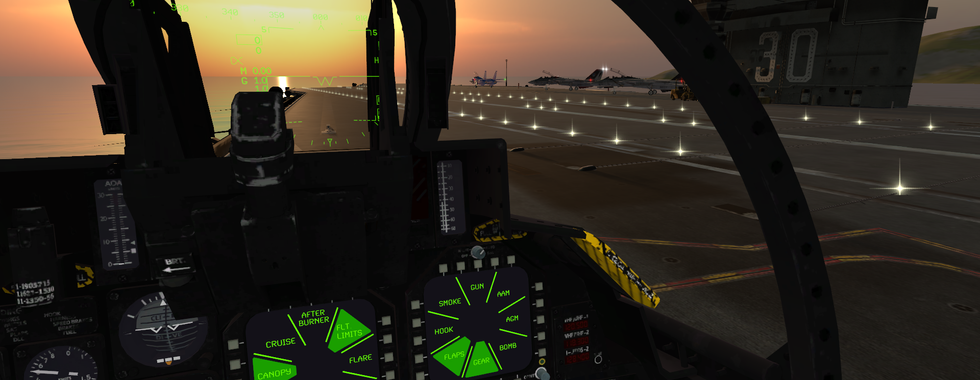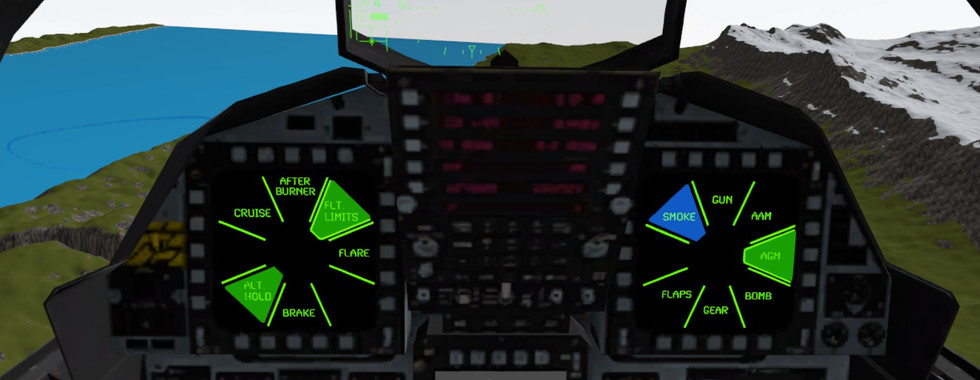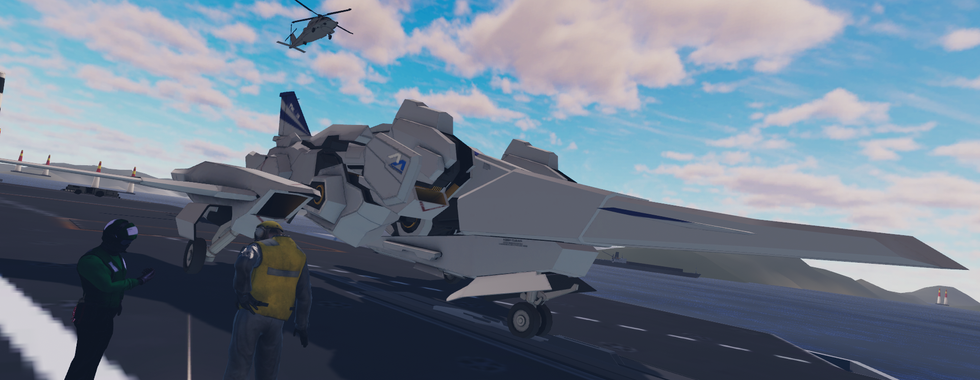VRChat Aviation: Flying in the Place Least Expected
- Aaron "Ribbon-Blue" Mendoza

- Jan 16, 2021
- 7 min read
Updated: Sep 23, 2022

VRChat (VRC), the free-to-play massively multiplayer online virtual reality social platform. The name in itself immediately conjures up memories of meme-worthy and cringe-worthy stories and videos that have circled social media and the blogosphere multiple times. This is undoubtedly how I visualized VRChat after seeing those videos and zinger articles about the wild things that can happen there. Two good friends encouraged me to give it a shot after getting a VR headset in March 2020. I'd be lying if I said I didn't experience some of the things I read about, but I had just happened to join right at the beginning of something that captivated me: skies full of contrails and roaring jet aircraft.
VRChat comprises over 25,000 worlds created by its users with a free to download software developer kit (SDK). This open resource has resulted in a world made for just about everything you could think of. I've seen cave diving, duck feeding, beach resorts, racing, amusement parks, Spider Man swinging, supermarkets, napping worlds, first-person shooters, galactic pirate ship raves, and too many others to list here. All of those worlds are populated by an eclectic mix of avatars that are original designs or come from TV shows, anime, video games, internet memes, and who knows where else. Aviation was never on my mind in a place where literally just about any setting is possible. The flight experiences I've had over these past months are something I believe could not be replicated in any other flight game.
VRChat launched on January 16th, 2014, but for VRC aviation, the all-important Udon software tool kit was released on April 1st, 2020, with SDK3. I personally don't have any experience with the software and programming languages needed to create these things, so I'm going to quote the text about what Udon is from the official website:
"VRChat Udon is a programming language built completely in-house by the VRChat Development Team. It is designed to be secure, performant, and easy to use via the VRChat Udon Node Graph, a built-in visual programming interface that uses nodes and wires (we call them "noodles") to connect flow, inputs, and outputs. You can build complex behaviors with Udon-- far more complex and easier to understand than unwieldy chains of Triggers and Actions. Not only can you replicate the full behavior of Triggers and Actions with VRChat Udon, but you can create your own behaviors, sync variables with others, interact with scenes, interact with players, and more. In addition, Udon runs in both the VRChat client and the Unity Editor, allowing you to test and debug your creations with ease." - What Is Udon?, VRChat Docs
When I started exploring in late March 2020, there were already worlds with flying vehicles and aviation themes. There are a few different flight systems in VRChat. It's essential to make the differentiation between two systems in particular as they are the most prolific.

Without getting too technical for now, the legacy system was less like flying and more like controlled levitation. Imagine a chair that players can sit in with hand controllers attached to it. Using the controllers, the chair can rotate and levitate in any direction at any speed. These chairs were incorporated into models of aircraft and spacecraft. In practice, from the runway, a plane could just rotate its nose upward until it stood on its tail, launch straight up like a rocket, stop in midair, rotate wings level, then "fly away." The guise of it being a more realistic flight system by maneuvering these vehicles in a way that mimicked actual aircraft could be maintained with some effort. There are a decent amount of these worlds that haven't received updates in years, so they're now in varying states of operation.
After the introduction of Udon, the public release of a world called Test Pilots on April 16th, 2020, changed everything. Created by Sacchan, this world was the first to use the Sacc Flight Script. Both then and now, this script is the most advanced flight system available in VRChat for both VR headset users and desktop users with keyboard and mouse controls. Initially, the Sacc Flight script had been tested and expanded upon through a joint venture by a team of creators, modelers, and trusted users that flew as testers working with Sacchan. From day one, everything had been assembled into a single free to download prefab that continues to receive updates.

After a major update on September 16th, 2020, the prefab provides a test aircraft with a fully customizable flight model. The flight model is in line with how many would assume an actual aircraft would fly. Airspeed, angle of attack, and turn rate are factors. Attempting a hard turn at high speeds can cause damage to the plane until it breaks apart. Controls include keyboard-mouse controls for desktop users or a virtual HOTAS that enables virtual reality users to fly with a pair of touch controllers. Think something similar to VTOL VR or Digital Combat Simulator VR, but with less cockpit button clicking. Aircraft can use air-to-air missiles, air-to-ground missiles with FLIR cameras, bombs, and guns with lead computing sights. Air brakes, flaps, retractable landing gear, air show smoke, flight limiters, autopilot, a working HUD, and other features can be managed using a VRChat specific multifunction display (MFD). For VR users, MFDs are controlled by rotating the touch controller thumbsticks to highlight functions and activate or deactivate functions with trigger presses. Even aircraft carrier operations are possible with arresting cables, catapults, and tail hooks. A second user can ride in a back seat if the vehicle is designed for it. They can join in for a joy ride, give flight instructions, or be a second pair of eyes during combat. Sacc Flight Script is also compatible with desktop users, which is something other flight experiences in VRC have lacked for years. On the backend, all of this is free to customize and add on to however the creator using it desires. There's a bit more to be mentioned, but check out the file and setting lists of some more information.
Starting from a baseline like this, creators began constructing their worlds. It is no exaggeration to say that the prefab was the seed needed to spur on the growth of new aviation worlds. These individual creators' ambitions and priorities have resulted in a wide array of options for VRChat users. The differences vary by map setting, time of day, type of aircraft, number of aircraft, tweaks to their flight models, types of weapons, and presence of airfields or aircraft carriers throughout the world. There are also deeper differences to consider. Like types of sensors and instruments only found in specific worlds (radar displays, ILS, PAPI, HSI, etc.), or worlds setup for one-time and recurring events.
For example, the earliest worlds include aircraft carrier-based air battles with F-14 Tomcats, an entire air base full of static display aircraft with a Japanese pop idol flair and even a Battle Fairy Yukikaze world that is gradually becoming more like a flight arcade game. Worlds that have appeared in the last few weeks include an F-35B simulator with working STOL, worlds with ten F/A-18F Super Hornets or a dozen YF-22s and F-117s and an air racing focused world utilizing a mecha style aircraft. There are also places to fly remote control drones and rotary-wing aircraft that aren't based on the Sacc Flight Script, but they are few and far between. Every few weeks it seems like a new world has been announced or is in development. At the time of this article being published, my research spreadsheet already has 23 worlds and counting.
Aircraft come from a variety of sources. Either models and sounds pulled from existing flight games and simulators, public creative commons databanks, or agreements between content creators. The fabrication of VRChat original designs is probably one of the most unexpected parts of its aviation community. There are multiple original aircraft designs, some with more real-world inspiration than others. Even original designs for warships and helicopters are being modeled for various uses. In particular, the MFDs are one of the most ingenuitive additions that have made the management of systems and subsystems possible for more advanced flight experiences. Even aircraft models "ripped" from other games have also been reconfigured to support the VRC specific MFDs.
Ultimately, the people who love and are interested in aviation are the driving force behind all of this. It takes many hours and days in Blender and Unity to develop worlds that are then used as hubs for people to fly, fight, and meet others. True to VRChat's original purpose, it's easy to strike up conversations with all sorts of people ranging from absolute newbies to aviation to people that have flown flight simulators or real aircraft most of their lives. This isn't something a majority of flight games and sims are designed for. It's undeniably one of the charms of the entire experience. But for those that want to fly alone or only with friends, creating a private instance is always an option.
Particularly passionate people have formed organizations like the Blue Horizons aerobatic team. The first of its kind in VRChat, this Japanese air show team has experience with the "Chair flight" system and Sacc Flight script. They practice and perform full airshow routines at public events and their own airfield (a private world).
The VRC Air Force began forming tournaments like their Dog Fight Events, which are bracketed battle royale events of pilots competing to be the champion, and recently, timed air racing events. They include large screens for an audience to watch each aircraft in flight, map displays that show player positions, start and stop alarms for events, even drone camera style setups that broadcast airborne views to those on the ground.
The aviation scene of VRChat is deeper than anyone could have suspected. It's not something that can be covered by this article alone, but this serves as a solid introduction.
About the Writer
Aaron "Ribbon-Blue" Mendoza

Co-founder of Skyward Flight Media. After founding Electrosphere.info, the first English Ace Combat database, he has been involved in creating flight game-related websites, communities, and events since 2005. He explores past and present flight games and simulators with his extensive collection of game consoles and computers. Read Staff Profile.












































.png)